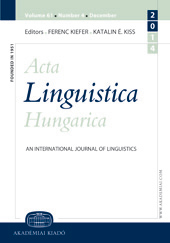Pál Pereszlényi and the development of morphological analysis in the early grammars of Hungarian
Pál Pereszlényi and the development of morphological analysis in the early grammars of Hungarian
Author(s): András CserSubject(s): Morphology, Finno-Ugrian studies, Philology
Published by: Akadémiai Kiadó
Keywords: morphological analysis; agglutination; affixes; stems; Hungarian;
Summary/Abstract: The morphological analysis of Hungarian in the early period of grammatical work was based on three interlaced traditions: Classical Graeco-Roman, Hebrew and German. These were applied to languages that were structurally very much unlike Hungarian. The evolution of morphological analysis was therefore a relatively slow and complicated process, whose milestones discussed in this paper, the four earliest grammars of Hungarian, all represent different stages of development. The grammar by Pál Pereszlényi, which is analysed in some detail here, surpasses the earlier grammars in its acumen on at least three counts: the same set of analytical terms is applied in the description of nominal and verbal morphology; the notions of bound stem and relative stem are clearly recognised; a distinction is made between stems as morphological constituents and word forms serving as starting points of paradigms.
Journal: Acta Linguistica Hungarica (Since 2017 Acta Linguistica Academica)
- Issue Year: 55/2008
- Issue No: 1-2
- Page Range: 3-21
- Page Count: 19
- Language: English

